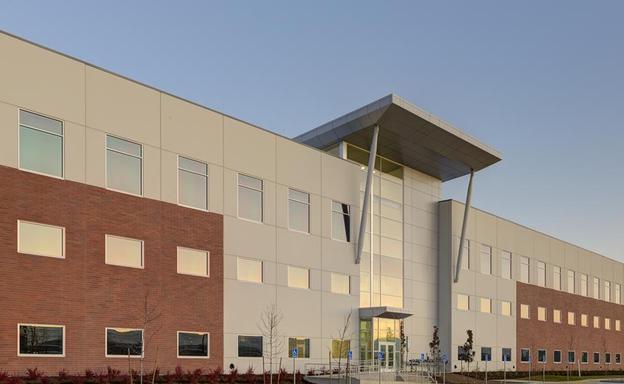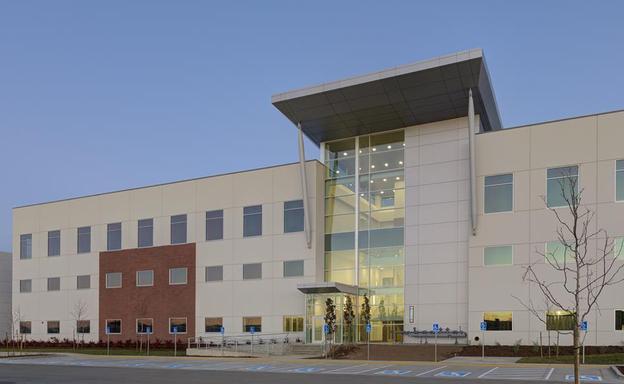Airport Technology Park Building G
Summarize the project's program, features, and achievements: Building G of the Airport Technology Park in Salt Lake City, Utah, was designed and built to house the operations department of a major aerospace and defense communications contractor. The entire campus is a stabilized mission control corporate headquarters. Building G allows the tenant to consolidate business operations that used to be spread across multiple facilities in the expansive campus into one building. This three-story concrete tilt-up building features a steel composite deck core. The advanced structural design without X-Bracing allows for clear and open use of the floorplate. The tilt panels made it possible to eliminate the need for steel brace frames and moment frames which allow the tenant to have more useable space. In addition to office space, the building also incorporates labs space, manufacturing, as well as design and testing space which required incredibly flat floors. The loading dock is able to accommodate five trucks at a time and was designed to be recessed into the first floor. This not only maximizes the usable area of the second floor above the loading dock, it also protects the dock from hazardous weather and allows the area to be fully secured, even while in use. Additionally, there is a 9,000 square foot courtyard located on the third floor to bring natural light and outside amenities to the third-floor office spaces. Building G is connected to the adjacent 900-stall parking garage by an enclosed pedestrian bridge, connecting the fourth level of the garage to the third level of the building.
What obstacles were overcome related to the schedule, budget, program, specification, site, etc. on this project? Because Building G was replacing an old building on an already existing campus, space was limited for construction crews. Due to this limited space, the slab on grade was used as the casting bed for all the exterior tilt panels. This required the building panels to be completed and tilted in two phases. During construction, the bracing for the tilt-up panels were located inside instead of outside the perimeter. All other construction of the three-story building needed to be erected around the bracing until the roof was in place. The slab on grade also needed special reinforcements and protection from the weight of the tilt-crawler crane. In addition to these reinforcements and protection, the need for exceptionally flat floors was required by the tenant in order to meet the demands of the lab and manufacturing spaces as well as the two-story auto storage system.
Please communicate any engineering complexities or unique features of the panel design for this project. ? Careful coordination was essential for the contractor with the tilt panels. Because the shear is mainly carried in the panels which also have windows, extensive reinforcing was needed. This reinforcing required brute force with sledge hammers to place the cross bracing. However, the embedded brick inlays that were cast into the panels affected the depth of the panels which added an additional level of care and coordination with the reinforcing. Another complexity that needed to be considered is the location of the building. Being located in an area of seismicity along a nearby fault, the concrete tilt-up panels were utilized for both gravity support of the building and the earthquake level forces.
What is the potential for this project's impact on the community and/or environment? This facility now serves as the tenant’s hub for developing cutting-edge communication technologies designed to protect the U.S. Military as well as citizens. This new hub also carries a significant economic impact for Utah and more specifically the Salt Lake Valley. During the grand opening and ribbon cutting ceremony, company representatives and state officials celebrated that the tenant’s organization will have a dramatic ripple effect on the community. The property tax is expected to be significant enough that it will provide substantial amounts of funding for education in local 7 and other civic improvements in the community. This facility is also designed to expand employment numbers from the current 1,000 to more than 4,000 employees in this building alone. This project allows for recent graduates and Utah residents to find satisfying careers locally without having to move to other large defense hubs like California or Texas.

Project Location
Salt Lake City, UT 84116
United States
TILT-UP ACHIEVEMENT AWARD
The Tilt-Up Achievement Awards were established to honor projects that use site-cast tilt-up concrete to introduce new building types, advance industry technology and provide unique solutions to building programs. Winning entries illustrate the variety, beauty, and flexibility of tilt-up construction.
ACHIEVEMENT
2023
The world’s greatest tilt-up structures are featured by the TCA as Tilt-Up Achievement Award Winners. Learn more >
Project Images
Project Team (TCA Members)
- Developer/Owner:
- General Contractor:
- Concrete Contractor:
- Architect:
- Engineer:
- Dunn Associates
- Suppliers:
- Photographer(s):
- Aaron Shaw
Project Specifics
- Project Category:
- Technology
- Building Types:
- Laboratory
- Finishes:
- Paint (Flat)
- Features:
- Formliner
- Reveals
- Insulation:
- Post Applied (Interior)
- Environmental:
- Number of Floors:
- 3
- Tilt-Up Wall Area:
- 56,100 sq ft (5,212 sq m)
- Total Floor Area:
- 406,000 sq ft (37,717 sq m)
- Project Footprint:
- 135,000 sq ft (12,542 sq m)
- Tallest Panel:
- 54 ft 6 in (16.61 m)
- Widest Panel:
- 20 ft 8 in (6.30 m)
- Largest Panel:
- 670 sq ft (62.2 sq m)
- Heaviest Panel:
- 101,000 lbs (45,813 kg)
- Longest Spandrel:
- 13 ft 4 in (4.06 m)








